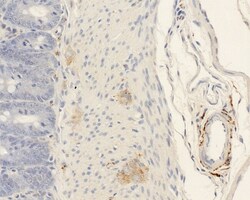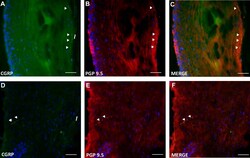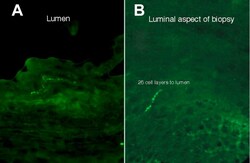Antibody data
- Antibody Data
- Antigen structure
- References [5]
- Comments [0]
- Validations
- Immunohistochemistry [1]
- Other assay [2]
Submit
Validation data
Reference
Comment
Report error
- Product number
- ABS 026-05-02 - Provider product page

- Provider
- Invitrogen Antibodies
- Product name
- CGRP Monoclonal Antibody (5)
- Antibody type
- Monoclonal
- Antigen
- Synthetic peptide
- Description
- ABS 026-05-02 detects CGRP alpha in human and rat samples. ABS 026-05-02 binds human alpha-CGRP. Based on inhibition ELISA, this antibody shows full cross-reactivity with rat alpha-CGRP and about about 50% cross-reactivity with human beta-CGRP. Cross-reactivity with coated rat alpha-CGRP is low (8%) and there is no cross-reaction with human amylin. ABS 026-05-02 has been successfully used in ELISA and immunohistochemistry procedures.
- Reactivity
- Human, Rat
- Host
- Mouse
- Isotype
- IgG
- Antibody clone number
- 5
- Vial size
- 400 μL
- Concentration
- 1.02 mg/mL
- Storage
- 4°C, store in dark
Submitted references UEG Week 2020 Poster Presentations.
United European gastroenterology journal 2020 Oct;8(8_suppl):144-887
A novel role for the extracellular matrix glycoprotein-Tenascin-X in gastric function.
The extracellular matrix glycoprotein tenascin-X regulates peripheral sensory and motor neurones.
Superficial Esophageal Mucosal Afferent Nerves May Contribute to Reflux Hypersensitivity in Nonerosive Reflux Disease.
Distinct afferent innervation patterns within the human proximal and distal esophageal mucosa.
United European gastroenterology journal 2020 Oct;8(8_suppl):144-887
A novel role for the extracellular matrix glycoprotein-Tenascin-X in gastric function.
Aktar R, Peiris M, Fikree A, Eaton S, Kritas S, Kentish SJ, Araujo EJA, Bacarin C, Page AJ, Voermans NC, Aziz Q, Blackshaw LA
The Journal of physiology 2019 Mar;597(6):1503-1515
The Journal of physiology 2019 Mar;597(6):1503-1515
The extracellular matrix glycoprotein tenascin-X regulates peripheral sensory and motor neurones.
Aktar R, Peiris M, Fikree A, Cibert-Goton V, Walmsley M, Tough IR, Watanabe P, Araujo EJA, Mohammed SD, Delalande JM, Bulmer DC, Scott SM, Cox HM, Voermans NC, Aziz Q, Blackshaw LA
The Journal of physiology 2018 Sep;596(17):4237-4251
The Journal of physiology 2018 Sep;596(17):4237-4251
Superficial Esophageal Mucosal Afferent Nerves May Contribute to Reflux Hypersensitivity in Nonerosive Reflux Disease.
Woodland P, Shen Ooi JL, Grassi F, Nikaki K, Lee C, Evans JA, Koukias N, Triantos C, McDonald SA, Peiris M, Aktar R, Blackshaw LA, Sifrim D
Gastroenterology 2017 Nov;153(5):1230-1239
Gastroenterology 2017 Nov;153(5):1230-1239
Distinct afferent innervation patterns within the human proximal and distal esophageal mucosa.
Woodland P, Aktar R, Mthunzi E, Lee C, Peiris M, Preston SL, Blackshaw LA, Sifrim D
American journal of physiology. Gastrointestinal and liver physiology 2015 Mar 15;308(6):G525-31
American journal of physiology. Gastrointestinal and liver physiology 2015 Mar 15;308(6):G525-31
No comments: Submit comment
Supportive validation
- Submitted by
- Invitrogen Antibodies (provider)
- Main image

- Experimental details
- Immunohistochemical analysis of CGRP alpha in paraffin-embedded rat tissue using a CGRP alpha monoclonal antibody (Product # ABS 026-05-02) after overnight incubation at a dilution of 1:400 in 1% BSA/PBS.
Supportive validation
- Submitted by
- Invitrogen Antibodies (provider)
- Main image

- Experimental details
- Fig. 5. Representative immunostaining for CGRP and protein gene product (PGP) in the proximal ( A-C ) and distal ( D-F ) esophageal mucosa.
- Submitted by
- Invitrogen Antibodies (provider)
- Main image

- Experimental details
- Fig. 4. Transverse sections of esophageal biopsies showing CGRP-immunoreactivity (lumen uppermost). A : example of a proximal esophageal biopsy, with CGRP-immunoreactive fibers a few cell layers from the luminal surface. B : example of a distal esophageal biopsy, demonstrating a nerve fiber in the basal epithelium (most superficial part of fiber 26 cell layers from the lumen). Images magnified x40. Scale bar represents 100 mum.
 Explore
Explore Validate
Validate Learn
Learn ELISA
ELISA Immunohistochemistry
Immunohistochemistry